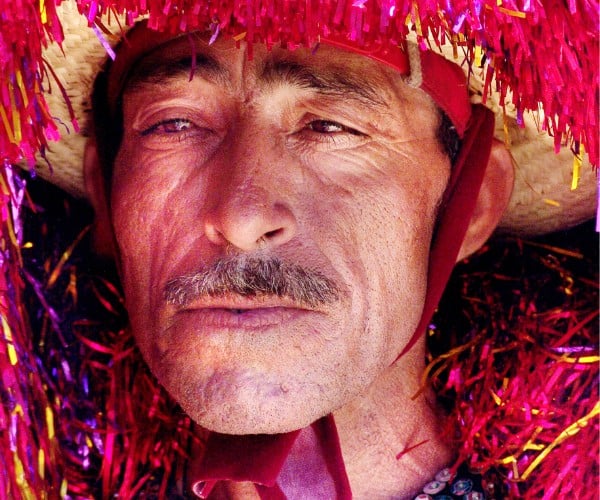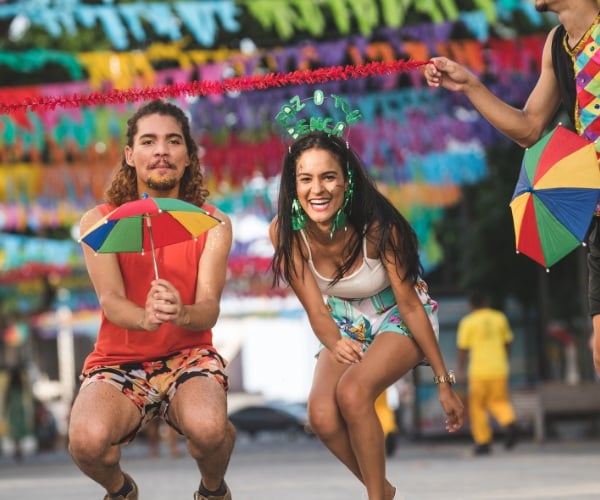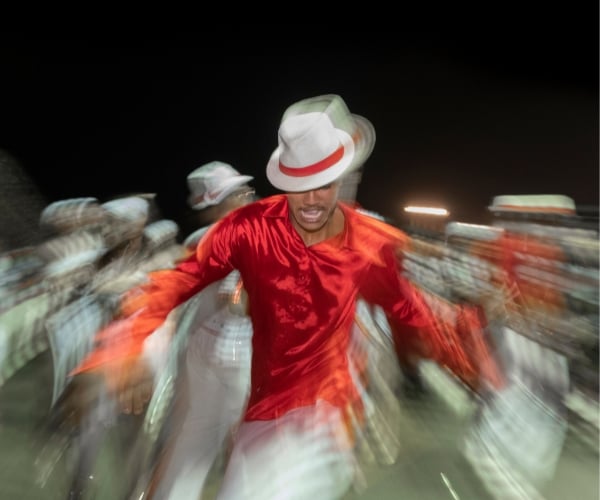Rhythms and sounds of Brazil: a musical palette
In a country of continental proportions like Brazil – with more than 8 million square kilometres (3.2 million square miles) – the rich diversity is reflected not only in the variety of ecosystems, but especially in the people, culture and musicality across the five different regions.
With a mixed population combining cultures from indigenous peoples, Europeans, and Africans brought during the colonial period, the result could not have been other than an explosion of rhythms and sounds that resonate in Brazilian daily life. In this geography of sounds, histories, and traditions, some rhythms better represent the identity of each region.
Bumba Meu Boi, Carimbó and Lambada
In the North, for example, the African culture, mixed with indigenous traditions and a touch of European influences, resulted in a colorful folklore festival called Bumba Meu Boi, which is celebrated throughout the Amazon region. Inspired by carimbó, the cheerful lambada is danced in pairs and conquered Europe in the late 1980s.

Once in the Amazon, a must-go in Manaus is the Amazon Theatre, where, in addition to visiting its imposing construction of eclectic Renaissance architectural style, you can watch spectacles of popular rhythms, dance, classical music, and drama. Opened in 1896, it was listed as a National Historic Heritage in 1966 and is considered one of the main venues for appreciating and disseminating cultural and artistic expressions in the region.
A few steps from the theater, you can stay at the charming Hotel Villa Amazônia. It is a historic mansion remaining from the golden age of the rubber industry that was completely restored. It has 30 apartments, all facing an incredible interior garden with a natural stone pool.
Frevo, Zabumba, Accordion and Axé
In the Northeast, no one can resist the beat of the frevo from Pernambuco and the triangles, zabumbas (drums), and accordions that dictate the engaging rhythm of forró in all the nine states of the region.

Forró is one of the best-known artistic expressions of this sunny region. It was created in Pernambuco and, like a migration, spread to other places, including outside Brazil. Tradition has it that the name comes from the English expression “for all”, referring to the parties thrown by English railway construction workers. The invitation was “for all”, which was adapted to the local pronunciation as “forró”.
Also in Pernambuco, frevo and maracatu dominate the great Carnival festival, especially in the town of Olinda, a major cultural hub in Brazil. Declared a Historical and Cultural Heritage of Humanity by UNESCO in 1982, in this municipality neighboring Recife the party is guaranteed with giant dolls that circulate among numerous groups of revelers on the streets.
After the party, a good option is to discover the coast of Pernambuco and rest in the best resort in the region, Nannai Muro Alto. Surrounded by Atlantic forest, coconut trees, and mangroves, the property faces an ocean protected by reefs, forming a natural pool of warm, crystal-clear waters.
In Bahia, axé is not only a music style but also a positive mood. Locals usually say they wish someone lots of “axé”. Amid batuques (drumming) and afoxés, the Bahian ginga (swing) has African roots and multiple meanings of religiosity, faith, and fight. Afoxés are Carnival blocks such as Ilê Aiyê (1974), the first Afro-Brazilian group to express the fight against racism through music, dance, and clothing, and Filhos de Gandhi, created by stevedores in 1949 to demonstrate nonviolence and peace – two examples of movements that honor the African roots of Brazilian culture.
In Salvador, an accommodation option is the renowned Fasano Salvador, which is housed in a historic building listed as a Cultural Asset of Bahia and was the first headquarters of the newspaper “A Tarde” for 45 years. Located in Castro Alves Square, in the Historic Center of Salvador, the hotel has unparalleled views of the Bay of All Saints.
Bossa Nova, MPB (Brazilian Popular Music), Samba, Rock (Samba Rock), Funk…
It is from the Southeast that the most well-known Brazilian genres around the world echo: samba, synonymous with Carnival and Brazil anywhere on the planet, and bossa nova, one of the most influential movements in Brazilian popular music, which began in the 1940s and was immortalized in numerous songs by its greatest voice, João Gilberto.

A meeting of Bahians, Paulistas, and Cariocas in 1968 resulted in the so-called Tropicália movement, a milestone in Brazilian culture, where irreverence and boldness with touches of guitar, long curly hair, and overly colorful clothes brought about changes not only in music, but also in morality and behavior. Influenced by the hippie counterculture, Brazilian popular music gained tones of rebellion, peace, and love in the voices of Gilberto Gil, Caetano Veloso, Gal Costa, Elis Regina, Tim Maia, Os Mutantes, and more.
IMPORTANT NOTICE:
If you are reading this article anywhere other than on A Luxury Travel Blog, then the chances are that this content has been stolen without permission.
Please make a note of the web address above and contact A Luxury Travel Blog to advise them of this issue.
Thank you for your help in combatting content theft.
And there is also Funk Carioca, which has hit the charts worldwide with Anitta’s voice and stage performance.
The cities of São Paulo and Rio de Janeiro have no shortage of options for concert venues and shows. Culture, music, art, and dance take place throughout the year in both metropolises. São Paulo has no shortage of luxury accommodation icons such as Fasano, Emiliano, and Unique. And Rio de Janeiro has Fasano, Emiliano Rio, Copacabana Palace (by Belmond Hotel), Fairmont Rio de Janeiro, and MGallery Santa Teresa, in the bohemian neighborhood of Santa Teresa.

The list of Brazilian rhythms, composers, and singers is long. This is not intended to cover the whole topic, but rather arouse your desire to “listen more to Brazil”.
Simone Scorsato is Executive Director of Brazilian Luxury Travel Association. BLTA’s main objective is to promote and strengthen Brazil as a travel destination to the global luxury market.
If you would like to be a guest blogger on A Luxury Travel Blog in order to raise your profile, please contact us.
Did you enjoy this article?
Receive similar content direct to your inbox.


A really nice post, too often we don’t pay enough attention to appreciating a country’s musical heritage.
Thank you, it is not possible to write in a unique post about your music …
When we toured Brazil, there was almost always music playing in the background. It’s helpful to learn a bit more about the soundtrack to our travels.
Great choice of photos. Lots of colour and movement. I can almost hear the beat.
Yeah lets dance
There are lots of reasons why I want to finally travel to Brazil. Now I’m going to have to add music to that list.
Yes, can you listen in Spotify our play list. The name is Brasil Incomparavel.
Now I can understand why the Latin dances so often bring out the best in the dancers on Strictly.
Yeah lets dance!
I really loved this piece as it roused so many half forgotten memories of my trip to Brazil a few years back. It maybe because I regularly play piano but for me the soundtrack to my trips is always an important part of my travel. I always feel that music reveals so much about a place and it’s people.